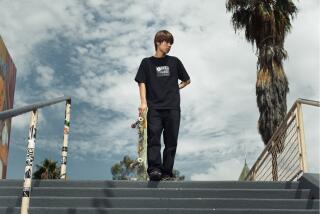‘It’s Like Being at the Top of a Roller-Coaster’
- Share via
It may seem contradictory, perhaps even sacrilegious, for someone employed by the Jet Propulsion Laboratory in Pasadena to be involved in hang gliding. After all, a glider’s only propulsion comes from rising air currents and the pilot’s running start.
But after only three hours in a glider, JPL college intern Fabian Nicaise was hooked.
“It really felt like flying,” said Nicaise after a recent tandem flight with an instructor that reached a peak elevation of about 4,000 feet. “It’s you and nature up there.”
Nicaise, a 21-year old Cheshire, Conn., native who is pursuing his license to fly small planes, recently took the first steps in learning to hang glide with two other JPL interns. They received instruction through Windsports Soaring Center in Van Nuys.
There, the three met with instructor Andy Beem, a rail-thin enthusiast of the sport. Learning to hang glide is not cheap. Beem says it costs at least $1,500 and takes between 45-60 hours of supervised practice to graduate beyond beginner status.
“Hang gliding’s not safe,” Beem said. “There’s always an element of risk involved. It’s up to us as instructors to manage that risk.”
Beem, 33, says he has never had an accident in 15 years of gliding. He is aware of one gliding fatality in the Los Angeles area in the past 12 years. Part of Beem’s admirable safety record has to do with preparation.
“You’re not going to learn to hang glide in 15-20 days, like some people think,” Beem said. “The learning process goes on for years.”
Nicaise and co-workers David Steck and Won Yoo began the process at Windsports’ “ground school,” an orientation session at the Victory Boulevard store. There, the theory of the sport one veteran pilot describes as “sailing in three dimensions” is covered in about an hour.
Several days later, the trio progressed to the “bunny hill” near the Runkle Reservoir in Simi Valley, where flights are capped at a height of about 10 feet. On a gently sloping dirt road, Beem led the group in a thorough equipment check and began his hands-on instruction.
The students first took turns balancing on their shoulders the glider, which is composed primarily of aluminum, steel cables and dacron cloth and weighs between 50-60 pounds. Beem had them rotate their bodies to observe how the wings dipped in response to the wind. Once the wings were level, they took long running steps down the road and eventually floated inches above the ground.
The bunny hill itself is a longer, steeper slope on which Beem clears a narrow runway through the knee-high grass. Starting about 40 feet up the hill, the students began to run with the glider balanced and Beem beside them.
“Eyes forward, light touch on the bar, let the glider do the work,” the instructor called out as the student picked up speed and the glider began to climb.
By the end of the four-hour session, progress was evident. Beem’s sweat-soaked shirt attested to numerous runs (and occasional tumbles) down the hill. The students’ pants were grass-stained from several rough landings but they were lifting off smoothly on each attempt and their expressions shone with accomplishment.
Yoo let out frequent whoops when he soared into the air. Steck’s excitement over a flight of about 50 yards caused him to land on his stomach in a prickly bush. Nicaise proclaimed that he was showing the glider who was boss.
A week later, the students took the next step--tandem flights with instructors from a 3,500-foot peak in Sylmar. Each pair ran down a 15-foot wooden ramp and eventually landed in a dry wash near the Sylmar Independent Baseball League fields.
Nicaise, who rode with Beem, had a two-hour flight that included frequent climbs through rising air currents known as thermals and the chance to look down on a commercial airliner.
“It gave me a new perception of the clouds and winds,” said Nicaise, who steered the glider for part of the flight. “Andy watches birds and the trees and other things to find the thermals.”
Steck, 21, was only able to fly for half an hour because of weather conditions. But he, like Nicaise, said once he has a steady income, he will likely pursue hang gliding further.
“It was definitely very cool,” Steck said. “At times you feel weightless, like being at the very top of a roller-coaster. When I got down, I noticed I had a sort of high.”
Beem said he works with about 20 students a year who become certified pilots and with another 40 who try only the beginning stages. He said few people outside the sport understand hang gliding.
“The general public still sees hang gliding as this death-defying sport,” Beem said. “But we’re just like any other pilot. It’s just that we use the air as our motor.”
More to Read
Sign up for The Wild
We’ll help you find the best places to hike, bike and run, as well as the perfect silent spots for meditation and yoga.
You may occasionally receive promotional content from the Los Angeles Times.






